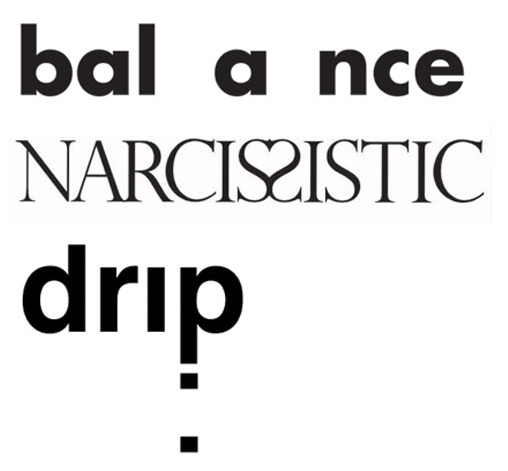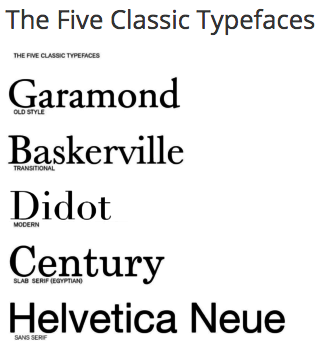Expressive Words
Modify a series of 3 words, one per 6″x6″ page, to express their meaning typographically.
It is said that a picture is worth a thousand words, but can one word become a picture? Graphic designers are often called to create expressive designs using only typography. Designer Ellen Lupton once wrote that “Typography is what language looks like” and your objective is to express the meaning of language using only letterforms. Using the five classic typefaces you will begin with a simple word and make the minimum changes necessary to effectively communicate the word visually.

Reread
Please take another look at The Design and the Play by Paul Rand. How does the concept of “play” inform this project?
Three Words / 9 Designs
You will work with three words:
- TWO from my list on this page — assigned by lottery
- ONE from mind maps you create
Format: 6” x 6” trimmed precisely (you will be graded on craft)
Color: Black and White Laser Print (no ink jet prints)
Create at least three different concepts (art boards) for each word.
To get three you will need to make more that you do not use.
You will have a total of 9 designs (and other exploratory sketches).
Word #1 and #2
Assigned by lottery:
- fright
- angry
- impulsive
- isolation
- tension
- energize
- rhythm
- radiant
- sorrow
- uneasy
- caffeine
- conflict
- scattered
- wander
- clumsy
- cheerful
- alarmed
- whimsical
- haunted
- overjoyed
- magnetic
- explosive
- surprised
- discombobulate
- splash
- kerplunk
- sizzle
- hiccup
- delightful
- slurp
- gurgle
- creak
- rebellious
- disoriented
- intrude
- provoke
- eccentric
Word #3 Mind Map

A mind map is a brainstorming technique to generate new directions and concepts.
Do a mind map with a group of classmates using your assigned words on the list above as the ‘seed.’ Let your minds wander and fill the page with associations. Circle a dozen or so verbs or adjectives that have expressive potential for you. Talk to classmates and select a few words to try. Choose these words carefully. Try not to be too abstract. Is there something about those words that suggest visual solutions? Don’t be obvious such as the word ‘Fall’ (and it is only four letters). Looking for a minimum of 5 letter words.
Define the Word in a Post
Create a post called the name of your words where you define the words for yourself in your own words based on your research. What did you learn about the word and its origin that you did not know already?
Use the category: “word definition”
Look up your word
Before you do anything, you need to find out what these words really mean. Do not rely on your imperfect idea of what you think a word means.
- The Oxford English Dictionary: You will need to log in but this is the master dictionary of the English Language.
- Consult three different dictionaries. Read the word origins too.
- Look your word up in a variety of printed dictionaries as well. They have many at the library.
The Five Classic Typefaces

You may use any typeface you want for any of your words as long as it is one of these five below. Use only the regular/book font (not bold or italic for instance).
- Garamond
- Baskerville
- Didot
- Century
- Helvetica
Be prepared to explain what typeface you used for which composition.
Dynamic Composition
Use the space of the frame dynamically. Create a layer that activates the tension between space and object. This usually means keeping the words smaller unless making them large is essential to the idea.
Place the words in different locations in the square. Where does the word communicate its idea the best? Use a variety of approaches to the designs. Do some words crop off the sides? Do all the letters fit into the space? Do letters want to overlap? Rotate? Flip? You will choose to change the position, scale and rotation of selected letters to express them.
Rules of the game
You MAY do the following:
- Rotate
- Scale proportionally
- Extend off the frame
- Repeat letters only when necessary…
You MAY NOT:
- Texture words
- Don’t stretch
- Cut the letters
- Use other typefaces
- Change the opacity (gray)
- Use outlines (solid letters only)
The Process
- Using Illustrator make a 6″x6″ file.
- Start your word in a selected typeface at 60 points.
- Place in the right place on the page in the correct typeface.
- Duplicate the artboard 2 times so you have the word + 2 copies.
- Change the typeface for each of the three artboards.
- Kern them all properly.
- Go to the the “Type” menu and select “Create Outlines” for each artboard.
- Ungroup the letters and begin working with them.
- Start with one change to communicate the word (scale, rotate, position). If you need more then try two changes (scale and rotate, or move two letters). Be conservative in the changes initially. Use only the graphic moves necessary to express the word.
- Activate the space in the composition to create a dynamic design.
- When you have expressed the word then move to the next artboard.
- Create more versions of each word than the required 3 designs to find the best solutions.
- Create at least three different concepts (artboards) for each of your three words for a total of 9 designs.
- Repeat steps 2-11 for additional two words.
Due by end of class, March 18th
Your word definition posts
Due Thursday, March 25th
- One PDF with all versions of the project uploaded to your dropbox folder. Must have at least 9 compositions.
Title the PDF 05 Expressive Words_lastname.pdf